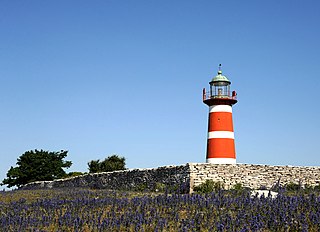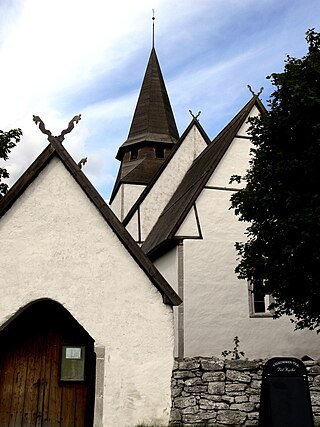
Hemse is a locality situated on the Swedish island of Gotland with 1,700 inhabitants in 2014. It is the second largest locality on the island. Hemse is the main center of population in the southern part of the island, and it is known for its markets.

Lärbro is a locality on the Swedish island of Gotland, with 963 inhabitants in 2014.

Havdhem is a locality situated on the Swedish island of Gotland with 300 inhabitants in 2014.

När is a populated area, a socken, on the Swedish island of Gotland, with 413 inhabitants in 2014. It comprises the same area as the administrative När District, established on 1 January 2016.

Lövsta is a locality on the Swedish island of Gotland, with 261 inhabitants in 2010.

Bäl is a populated area, a socken, on the Swedish island of Gotland. It comprises the same area as the administrative Bäl District, established on 1 January 2016.

Dalhem, is a populated area, a socken, on the Swedish island of Gotland. It comprises the same area as the administrative Dalhem District, established on 1 January 2016.

Eskelhem is a populated area, a socken, on the Swedish island of Gotland. The area is rural with farms. It comprises the same area as the administrative Eskelhem District, established on 1 January 2016.

Akebäck is a populated area, a socken, on the Swedish island of Gotland. It comprises the same area as the administrative Akebäck District, established on 1 January 2016.

Sundre is a populated area, a socken, on the Swedish island of Gotland. It comprises the same area as the administrative Sundre District, established on 1 January 2016.

Hörsne-Bara is a populated area, a socken, on the Swedish island of Gotland. Formerly two sockens, Hörsne and Bara, Bara was merged with Hörsne under the name Hörsne socken or Hörsne with Bara socken. It comprises the same area as the administrative Hörsne-Bara District, established on 1 January 2016.

Ala is a populated area, a socken, on the Swedish island of Gotland. It comprises the same area as the administrative Ala District, established on 1 January 2016.

Boge is a populated area, a socken, on the Swedish island of Gotland. It comprises the same area as the administrative Boge District, established on 1 January 2016.

Ekeby is a populated area, a socken, on the Swedish island of Gotland. It comprises the same area as the administrative Ekeby District, established on 1 January 2016.

Endre is a populated area, a socken, on the Swedish island of Gotland. It comprises the same area as the administrative Endre District, established on 1 January 2016.

Etelhem is a populated area, a socken, on the Swedish island of Gotland. It comprises the same area as the administrative Etelhem District, established on 1 January 2016.

Follingbo is a populated area, a socken, on the Swedish island of Gotland. It comprises the same area as the administrative Follingbo District, established on 1 January 2016.

Gammelgarn is a populated area, a socken, on the Swedish island of Gotland. It comprises the same area as the administrative Gammelgarn District, established on 1 January 2016.

Ganthem is a populated area, a socken, on the Swedish island of Gotland. It comprises the same area as the administrative Ganthem District, established on 1 January 2016.

Klinte is a populated socken on the Swedish island of Gotland. It comprises the same area as the administrative Klinte District, established on 1 January 2016.






















